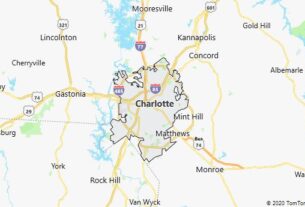Geography of Clinch County, Georgia
Located in the southeastern region of the United States, Clinch County, Georgia, is nestled amidst the verdant landscapes of the Coastal Plain region. Its geography, characterized by diverse terrain, intricate river systems, and a subtropical climate, plays a pivotal role in shaping the county’s environment, economy, and way of life.
Topography and Landforms:
According to A2zgov, Clinch County encompasses an area of approximately 824 square miles, with varied topography that includes rolling hills, fertile plains, and gently sloping terrain. Situated within the Atlantic Coastal Plain, the county’s landscape is largely defined by its low-lying elevation, with elevations ranging from around 100 to 300 feet above sea level. The region’s geology predominantly consists of sedimentary deposits, including sand, clay, and loam, which have been shaped over millennia by erosional forces and the meandering paths of rivers.
To the north, the terrain gradually rises towards the Piedmont Plateau, while to the south lies the expansive Okefenokee Swamp, one of the largest freshwater wetlands in North America. These contrasting landscapes contribute to the county’s ecological diversity and provide habitats for a rich array of plant and animal species.
Rivers and Waterways:
The hydrology of Clinch County is defined by its intricate network of rivers, creeks, and waterways, which play a vital role in sustaining both natural ecosystems and human activities. The county is intersected by several significant rivers, including the Suwannee River, which forms its eastern boundary, and the Alapaha River, which flows through its western reaches.
The Alapaha River, known for its scenic beauty and biodiversity, originates in southern Georgia and meanders southward through Clinch County before converging with the Suwannee River. Along its course, the river is fed by numerous tributaries, such as Big Creek and Cow Creek, which contribute to the region’s fertile soils and provide essential water resources for agriculture and wildlife.
In addition to its rivers, Clinch County is dotted with numerous creeks and streams, which crisscross the landscape and drain into larger water bodies. These waterways, including Willacoochee Creek and Swift Creek, are lifelines for the county’s ecosystems, supporting diverse aquatic habitats and serving as corridors for migratory species.
Lakes and Wetlands:
While Clinch County is not known for its large lakes, it is home to several smaller water bodies, including ponds, reservoirs, and oxbow lakes. These features contribute to the county’s natural beauty and provide recreational opportunities for residents and visitors alike.
One notable wetland area within Clinch County is the Banks Lake National Wildlife Refuge, located near the town of Lakeland. This 4,049-acre refuge encompasses a diverse mosaic of habitats, including cypress swamps, marshes, and open water, and provides sanctuary for a plethora of wildlife species, including migratory birds, alligators, and amphibians.
Climate:
Clinch County experiences a humid subtropical climate, characterized by hot, humid summers and mild winters. The region’s climate is influenced by its proximity to the Gulf of Mexico and the Atlantic Ocean, which moderate temperatures and contribute to the high levels of humidity.
Summer temperatures in Clinch County typically range from the upper 80s to low 90s Fahrenheit, with occasional spikes into the upper 90s during periods of intense heat. Humidity levels can be significant during the summer months, contributing to a sultry, tropical feel.
Winters in Clinch County are generally mild, with temperatures averaging in the 50s and 60s Fahrenheit. While frost and freezing temperatures are not uncommon, prolonged periods of cold weather are rare, and snowfall is a rare occurrence.
The county experiences a distinct wet and dry season, with the majority of rainfall occurring between April and September. Thunderstorms are common during the summer months, fueled by the clash of warm, moist air masses from the Gulf of Mexico and cooler, drier air from the north.
Vegetation and Wildlife:
The diverse geography and favorable climate of Clinch County support a rich tapestry of vegetation and wildlife. The county’s forests are predominantly composed of pine and hardwood species, including loblolly pine, longleaf pine, oak, and hickory, which provide habitat for a wide variety of wildlife species.
In addition to its forests, Clinch County boasts extensive grasslands, wetlands, and riparian habitats, which support a diverse array of plant and animal life. These habitats are home to numerous species of birds, mammals, reptiles, and amphibians, including white-tailed deer, wild turkeys, bobcats, and various species of waterfowl.
The waterways of Clinch County are particularly rich in biodiversity, supporting a myriad of fish species, including bass, catfish, and bream, as well as freshwater mussels, crayfish, and aquatic plants.
Conclusion:
The geography of Clinch County, Georgia, is characterized by its diverse terrain, intricate river systems, and subtropical climate. From the fertile plains and rolling hills to the meandering rivers and lush wetlands, the county’s landscape is both beautiful and bountiful, providing habitat for a rich array of plant and animal species. Whether exploring the tranquil waters of the Alapaha River or hiking through the pine forests of the Piedmont Plateau, Clinch County offers a wealth of natural wonders waiting to be discovered.


